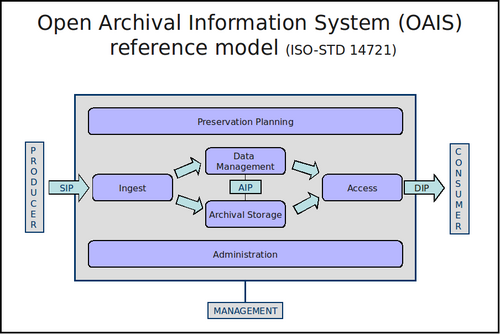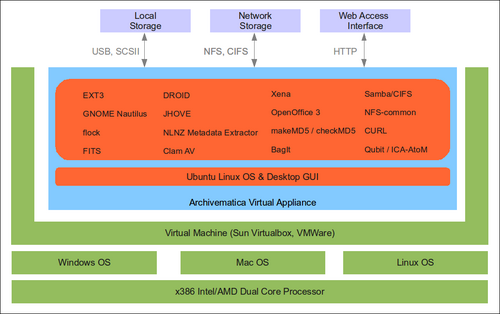Overview
Main Page > Overview
The Archivematica project is integrating a number of open-source tools to create a comprehensive digital archives system that is compliant with the ISO-OAIS functional model and other digital preservation standards and best practices.
Using the latest in virtualization technology, each release of the system is packaged as a virtual appliance, making it possible to run on any consumer-grade hardware and operating system, even directly from a USB key. This means an entire suite of digital preservation tools is now available to the average archivist from one simple installation.
Archivematica does not prescribe a specific SIP format, essentially accepting files for ingest with as much or as little metadata as is available. It runs the SIP through standard quarantine, identification, validation, metadata extraction and normalisation processes using a variety of tools such as FITS, Xena and Clam AV.
Archivematica packages AIPs using PREMIS, METS and Library of Congress’ Bagit format. The Archivematica virtual appliance is able to interact with any number of networked or external storage devices to allow for the flexible implementation of an archival storage and backup strategy, which can range from using a simple filesystem to sophisticated vendor storage arrays. It then prepares DIP access derivatives and sends these to a web-enabled application such as ICA-AtoM or Archon for further enhancement of descriptive metadata, integration into existing institutional archival descriptions and public access.
The project goal is to give archivists with limited technical and financial capacity the tools, methodology and confidence to begin preserving digital information today. The project has conducted a thorough [[OAIS Use Cases|OAIS use case] and process analysis to synthesize the specific, concrete steps that must be carried out to comply with the OAIS functional model from Ingest to Access. Wherever possible, these steps are assigned to software tools within the Archivematica system. If it is not possible to automate these steps in the current system iteration, they are incorporated and documented into a manual procedure to be carried out by the end user, including file format-specific preservation plans. This ensures that the entire set of preservation requirements is being carried out, even in the very early iterations of the system. In short, the system is conceptualized as an integrated whole of technology, people and procedures, not just a set of software tools.
Archivematica is still in early development and recognizes that it will always have technical gaps to fill, given the extraordinary complexity of the digital preservation domain. Therefore, the project has established an agile and open development methodology which is focused on rapid, iterative release cycles, each of which improves incrementally upon the system's requirements, software and documentation.

